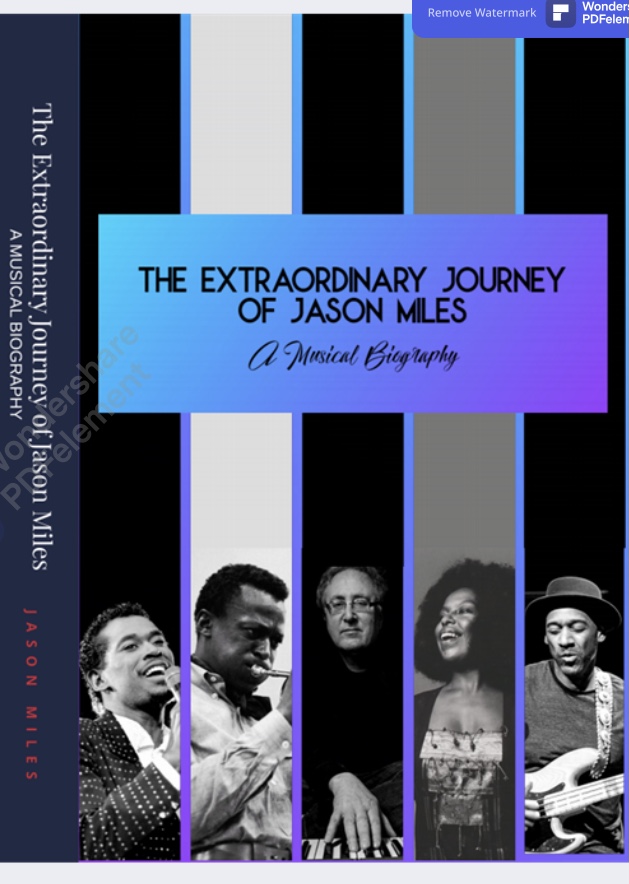Home » Jazz Articles » Book Review » The Extraordinary Journey Of Jason Miles: A Musical Biography
The Extraordinary Journey Of Jason Miles: A Musical Biography
 The Extraordinary Journey of Jason Miles: A Musical Biography
The Extraordinary Journey of Jason Miles: A Musical Biography Jason Miles
311 Pages
ISBN: # 978-1-955901-13-0
Book Writing Cube
2022
Some musicians are often better known for what they can do rather than what they can play. Take Les Paul for example. Although he was an excellent musician in his own right, he is sometimes recognized as much, or more, for his innovations in recording than his playing. Keyboardist Jason Miles would also fit into this category. While he is a talented keyboard player with an impressive discography, he is perhaps better known for his work in musical technology, and he discusses his story in The Extraordinary Journey of Jason Miles: A Musical Biography.
Miles was in the right place at the right time for some of the most important technological advances in music. He has also worked with an impressive list of musicians including David Sanborn, Marcus Miller, Luther Vandross and Miles Davis. He was the go-to guy among many top recording artists who wanted to get the best sounds from cutting-edge technology.
The Extraordinary Journey of Jason Miles... doesn't spend a great deal of time covering Miles' early years. He gives just enough background information and quickly moves into his professional experience. Although he had the opportunity to work closely with some significant musical celebrities, Miles is not relying on sensationalism to attract readers. This is not the place to find celebrity gossip. Instead, this is a heartfelt account of personal experiences from someone who truly loves music. Miles is a talented storyteller, and his narrative style is natural and effective.
Music studios were a template for technological innovation during the late sixties and early seventies. Instruments like the Mellotron and the Moog synthesizer were being incorporated more and more into musical recordings, and jazz was no exception. Musicians such as Joe Zawinul and Herbie Hancock were incorporating electronics into their albums. Hancock's 1973 release Headhunters (Columbia), for example, quickly gained popularity and ultimately became one of the most popular jazz recordings of all time. As a result, many other jazz artists wanted to incorporate electronics into their music.
There was a problem, though. The new technology came with a substantial learning curve, and incorporating these sounds was not as easy as simply flipping a switch. This is where Jason Miles comes in. Along with being a musician, Miles understood technology. By the early eighties, he started to gain a reputation because he knew how to use these new tools.
The story actually begins with saxophonist Michael Brecker running into Miles at a sushi restaurant. Brecker was looking for a Yamaha DX7 synthesizer, which was very popular at the time, but they were difficult to come by. Being at the forefront of cutting-edge technology, Miles was able to locate one of the instruments for Brecker, and help him get the sounds he wanted out of the instrument.
Although Miles was an accomplished composer and arranger, he found himself in a difficult situation. He explains, "I would get gigs, but I wouldn't get that major gig. It seemed to always go to someone else." Instead, he gained a reputation as someone who could work magic behind the scenes. Major artists started contacting him to help them because they knew of his experience with technology.
Much of this came about through a chance meeting with drummer Lenny White. Brecker invited Miles to a party with several famous artists in attendance. At one point, White introduced himself, and the two hit it off. This encounter became one of the pivotal moments in Miles' life because White invited him to help in the studio with The Jamaica Boys, which was a group featuring White, bassist Marcus Miller, and vocalist Mark Stevens. Although the group would not release an album until later, this involvement resulted in new opportunities for Miles.
Miller was impressed with Miles' work and invited him to help out with the recording of Miles Davis's Tutu (Warner Brothers, 1986). This was a major moment for Jason. He recalls seeing Davis perform during the mid-seventies and only wishing he could someday work with him. Now his dream was coming true. However, up to this point, Miles still needed the approval of Davis before he was officially on board. Davis was known for his enigmatic behavior, and Jason Miles describes how his "heart was beating like a rabbit's" when the two met. He approached Davis and said, "I just want to introduce myself. My name is Jason Miles." Davis looked him over and calmly replied, "I like your name." After that, the working relationship was sealed, and Miles continued to work with Davis until the latter's death in 1991.
Miles's journey depicted here, however, is not all centered around his recording experiences with A-list artists. He refers to himself as "the low man on the totem pole of the upper echelon" and has endured his share of struggles. Some of these difficult situations came in the recording studio, but others were personal setbacks. Through it all, though, Miles offers a sense of hopefulness and optimism. The Extraordinary Journey of Jason Miles... is a well-written and engrossing account of a musician who is passionate about everything he creates.
Tags
Book Review
Kyle Simpler
Book Writing Cube
Les Paul
Jason Miles
David Sanborn
Marcus Miller
Luther Vandross
Miles Davis
Joe Zawinul
Herbie Hancock
Michael Brecker
Lenny White
PREVIOUS / NEXT
Support All About Jazz
 All About Jazz has been a pillar of jazz since 1995, championing it as an art form and, more importantly, supporting the musicians who make it. Our enduring commitment has made "AAJ" one of the most culturally important websites of its kind, read by hundreds of thousands of fans, musicians and industry figures every month.
All About Jazz has been a pillar of jazz since 1995, championing it as an art form and, more importantly, supporting the musicians who make it. Our enduring commitment has made "AAJ" one of the most culturally important websites of its kind, read by hundreds of thousands of fans, musicians and industry figures every month.

























